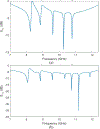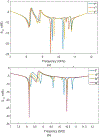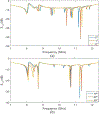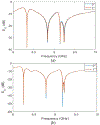Multi-Bit Chipless RFID Sensing Methodology for Rotation Determination
- PMID: 35237761
- PMCID: PMC8886549
- DOI: 10.1109/i2mtc43012.2020.9129085
Multi-Bit Chipless RFID Sensing Methodology for Rotation Determination
Abstract
Chipless RFID tags can be used for both identification and sensing applications. While binary codes are assigned to the responses of ID tags, they typically are not assigned to the responses of sensing tags. Instead, changes in tag response characteristics, like notches, are related to a sensing parameter. While this provides for a straightforward sensing mechanism, it can be limiting in terms of the dynamic range and sensing resolution that can be achieved. This paper proposes assigning multi-bit codes to the responses of sensing tags in order to better capture the effect of the sensing parameter on the tag response and provide greater sensing capabilities. This is done in the context of a rotation sensing with a tag that is capable of sensing 1° rotations from 0° to 180°. It is also shown that using tags with higher notch densities for sensing can result in better sensing resolution.
Keywords: chipless RFID; resolution; rotation; sensor.
Figures











References
-
- Ramakrishnan KM and Deavours DD, “Performance Benchmarks for Passive UHF RFID Tags,” in 13th GI/ITG Conference - Measuring, Modelling and Evaluation of Computer and Communication Systems, 27–29 March 2006 2006, pp. 1–18.
-
- Karmakar NC, Amin E, and Saha JK, Chipless RFID Sensors New York, UNITED STATES: John Wiley & Sons, Incorporated, 2016.
-
- Preradovic S and Karmakar N, Multiresonator-Based Chipless RFID Barcode of the Future Springer; 2012.
-
- Nguyen DH, Zomorrodi M, and Karmarka NC, “Spatial-Based Chipless RFID System,” IEEE Journal of Radio Frequency Identification, pp. 1–1, 2019, doi: 10.1109/JRFID.2018.2887162. - DOI
-
- Athauda T and Karmakar N, “Chipped Versus Chipless RF Identification: A Comprehensive Review,” IEEE Microwave Magazine, vol. 20, no. 9, pp. 47–57, 2019, doi: 10.1109/MMM.2019.2922118. - DOI
Grants and funding
LinkOut - more resources
Full Text Sources
